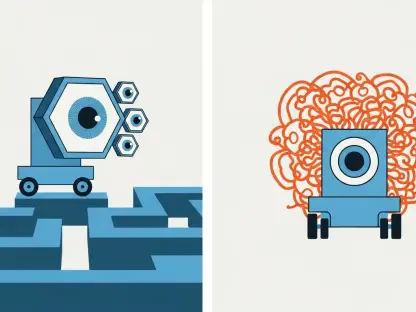In recent discussions, the deployment methods of artificial intelligence models have surfaced as a critical factor influencing their security and effectiveness. This has particularly gained attention following significant security breaches within AI systems and underscores the importance of data handling and infrastructure choices. A Chinese company, DeepSeek, has been at the center of this conversation with its AI models: DeepSeek Chat (V3) and R1. These tools are designed for different tasks, with Chat focused on conversational AI and R1 aimed at complex problem-solving. However, a major incident in February of this year where DeepSeek experienced a security breach has cast a shadow on the deployment practices, raising questions about vulnerabilities related to these models despite their cost-effectiveness compared to other counterparts like OpenAI.
The necessity to evaluate these models beyond their operational capabilities cannot be overstated, as they encapsulate both strengths and weaknesses influenced by their deployment framework. This becomes particularly relevant when examining the operational efficiency of DeepSeek Chat in natural language processing tasks. By employing a Mixture-of-Experts architecture, Chat optimizes its performance by activating only necessary segments, thus excelling in applications requiring quick processing tasks like content creation. This stands in stark contrast to DeepSeek R1, which, despite offering slower operations, targets complex reasoning and coding challenges with much-needed accuracy and depth.
The Security Challenge
The security breaches that have impacted DeepSeek models reveal deeper issues tied to deployment configurations. During the notable data exposure incident, vulnerabilities were highlighted that are crucial in understanding the trade-offs between security and budget considerations when deploying these models. Local deployment is positioned as a mitigating strategy, reducing exposure risks when compared to cloud-based approaches. With servers for DeepSeek models located in China, common concerns arise over data privacy and compliance, especially for applications dealing with sensitive information.
Further amplifying these concerns is R1’s inability to effectively counter harmful prompts, which presents liability risks to users. Compared to this, the local deployment of these AI tools offers an attractive alternative, emphasizing the importance of safeguarding data and ensuring compliance with international standards. Such a strategy allows organizations to control data pathways and access, eliminating the outsider risks associated with cloud-based systems. This bolstered security promise of local deployment needs to be continually evaluated, and selecting between cloud or local infrastructure becomes pivotal based on the model application and the data it processes.
The Functional Comparison
Functionality and applicability emerge as other dimensions to consider when comparing DeepSeek Chat and R1. These AI models serve distinct purposes; Chat thrives in scenarios that demand efficient conversational workflow, optimizing speed and fluidity. Leveraging its Mixture-of-Experts architecture effectively, DeepSeek Chat enhances performance for users by streamlining communication-related tasks and content workflow. Alternatively, R1 shines by solving complex problems and presenting intricate coding solutions, aimed at fields needing precise calculations.
The success of DeepSeek R1 in mathematical reasoning is validated by its remarkable 97.3% score on the MATH-500 benchmark. Moreover, its superior performance in generating sophisticated algorithms is evident, with a 96.3% performance rating on Codeforces. However, R1’s prowess comes with trade-offs, including a longer processing time to ensure accuracy and completeness, which is notably backed by an extensive context window of 64,000 tokens. These differentiations highlight the importance of aligning model capabilities with their intended application, ensuring that the right tool is deployed for the designated task to offer optimal outputs.
Financial Implications and Strategic Allocation
The implications tied to cost are inevitable when considering the deployment of any AI model, and financial aspects weigh considerably on the application choice between Chat and R1. Here, R1, although robust in function, is a more expensive investment at US$2.19 per million tokens compared to Chat’s US$1.10. This financial disparity can translate into substantial differences over significant uses, especially at scale. As organizations strategize on which model to deploy, the balance between functionality, cost, and the risk of deployment becomes clear.
Selecting between Chat and R1 requires a strategic allocation based on specific tasks, promoting efficiency while staying within budget constraints. Applying R1 in technical environments that demand its advanced reasoning capabilities while reserving Chat for scenarios necessitating quick, fluent communication can maximize both performance and resource allocation. The integration of these models demands a nuanced approach that looks beyond simple benchmarks, focusing instead on tailoring deployment to meet organizational needs effectively.
Strategic Deployment for Enhanced Model Utilization
The deployment methods of artificial intelligence (AI) models have recently emerged as crucial determinants of their security and effectiveness. This concern has drawn increasing attention following notable security breaches in AI systems, highlighting the importance of data management and infrastructure decisions. A Chinese company, DeepSeek, plays a significant role in this dialogue with its AI models: DeepSeek Chat (V3) and R1. Each is tailored for specific tasks, with Chat emphasizing conversational AI and R1 focused on solving complex problems. A key event in February saw DeepSeek facing a security breach, raising concerns about potential vulnerabilities in their deployment practices. Despite being cost-effective compared to competitors like OpenAI, these models demand scrutiny beyond their operational prowess. For instance, DeepSeek Chat excels in natural language processing through a Mixture-of-Experts design, activating only necessary parts for rapid applications like content creation. Meanwhile, DeepSeek R1, though slower, is engineered for complex tasks requiring precision, such as reasoning and coding.









